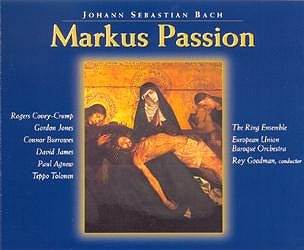According to one of his obituaries (co-written by his
son C.P.E. Bach), J.S. Bach wrote five Passions, though one might
be a version of the St. Matthew Passion with just one chorus. Of
the St. Mark Passion, only the text has come down to us (thanks
to the publication of the poet Picander's complete works). The reconstruction
of the St. Mark Passion is based on the theory that the metre of
the surviving text matches movements from various other of his works.
J.S. Bach used this "parody" procedure in other works, so it is
plausible that he did so here. The primary sources are the Trauer
Ode BWV 198 and the cantata Widerstehe doch der Sünde, BWV
54.
The reconstruction on this recording is by Dr.
Simon Heighes. Dr. Heighes has had to exercise some ingenuity,
as BWV 198 and BWV 54 do not provide all the text, so he has cast
his net wider. Regarding the choruses and recitative, Heighes
has included some music from Reinhard Keiser's St. Mark Passion
(a work that influenced Bach). But, despite all this ingenuity,
Heighes has had to fill in some gaps with newly composed music.
With advances in Bach scholarship, it is now
becoming accepted that Bach performed his Passions with what we
would nowadays regard as unfeasibly small forces. So this performance,
on the original instruments of the European Baroque Orchestra
with the Finnish choir, The Ring Ensemble, is not so much an 'authentic'
reconstruction of one of Bach performances, but rather the sort
of performance that Bach might have aspired to.
The Evangelist is sung by tenor Rogers Covey-Crump
and his mellifluous high tenor is a constant joy to listen to.
Attentive to the words, his makes a most moving Evangelist.
Baritone Gordon Jones, who sings in the Hilliard
Ensemble with Covey-Crump, sings Jesus. Jones makes a fine, moving
Jesus with just a hint that the part might suit a bass-baritone
better. Jesus's part is almost exclusively sung in an attractive
arioso, accompanied by strings. But I am not clear whether this
halo effect is original or something added by Dr. Heighes.
The soprano solos are sung by treble Connor Burrowes.
He manages his two arias with style and enough bravura that I
forgave him the occasional smudged patches. The alto solos are
sung by another Hilliard Ensemble member, David James. James is
a fine stylist, but on this recording his voice production is
very mannered. He constantly sounds as if he is squeezing the
voice out and, from the way he was shading out the high notes,
I felt that the part lies a little too high for him. This is a
shame as his two long arias, with their complex accompaniments,
are amongst the finest in the work. The tenor and baritone soloists
get one aria each. Paul Agnew sings his aria magnificently and
his performance is one of the highlights of the disc, I only wish
he had more to do. Baritone, Teppo Tolonen seemed less comfortable
with the virtuoso passages in his aria.
At first sight, the structure of the passion
seems a bit curious with two long alto arias, two shorter treble
arias and a single aria for tenor and bass. But, given Bach's
resources, this distribution would mean that he could perform
the passion with just four soloists (Evangelist singing the tenor
aria and Jesus the baritone aria), perhaps with the addition of
four ripieno singers for the chorales.
The choruses, which have been taken from Keiser's
passion, sound alarmingly similar to those written by Bach for
the St. Matthew Passion. Besides the chorales and the turbae,
the chorus get some more substantial movements to sing, notably
the opening chorus, the chorus closing CD 1 and the chorus closing
the entire piece. These are some of the most developed pieces
in the work and the Ring Ensemble rise to the challenge and sing
magnificently.
But it is the European Union Baroque Orchestra
who make this recording special. The choruses and arias are all
richly orchestrated and the orchestra play with style and élan,
frequently with a spring in their step. They also sound as if
they are enjoying themselves.
Roy Goodman controls proceedings admirably. His
speeds are on the brisk side and there were moments where I felt
the performance was too hectic, but he does allow time when it
is needed.
This is not the most contemplative of Bach's
passions (if it can be said to be by Bach). But even if Dr. Heighes
is correct in his reconstruction, what the work lacks is the final
touches of Bach's genius. No matter how much pre-existing music
Bach actually used in this work, we can never know what changes
he made to fit them to their new surroundings. And the problem
for those familiar with Bach's music, is that movements re-used
from other works still sound as if they ought to be in their old
positions. This reconstruction includes some of the loveliest
music from Bach's cantatas, but it can be difficult accept that
it forms a single whole new work. For those interested in hearing
alternative reconstructions, then Ton Koopman has produced his
own which does not use BMV 198 and he has written his own recitatives.
He has recorded the work with his Amsterdam Baroque Orchestra.
But Roy Goodman and the European Union Baroque Orchestra give
Dr. Heighes's reconstruction a very committed performance and
by the end they almost had me convinced. I will never quite appreciate
this work the way I do the St. John and the St. Matthew, but this
recording gives us a chance to hear what it might have sounded
like.
Robert Hugill
